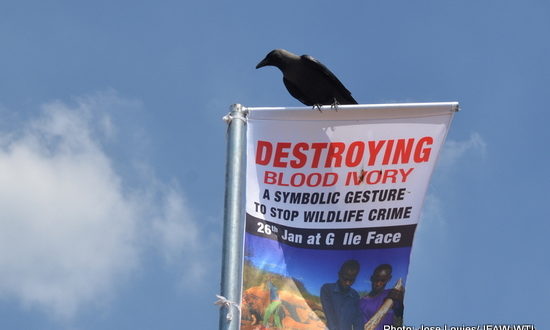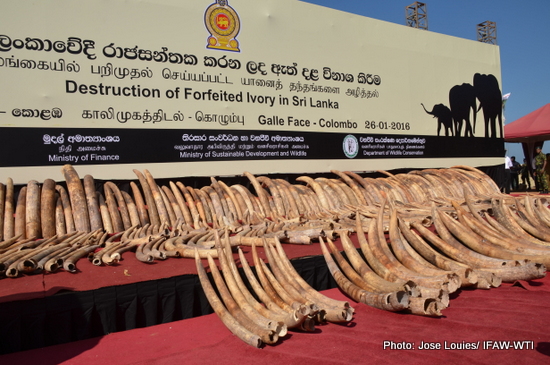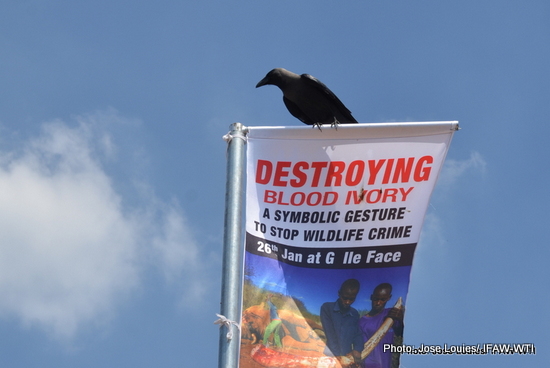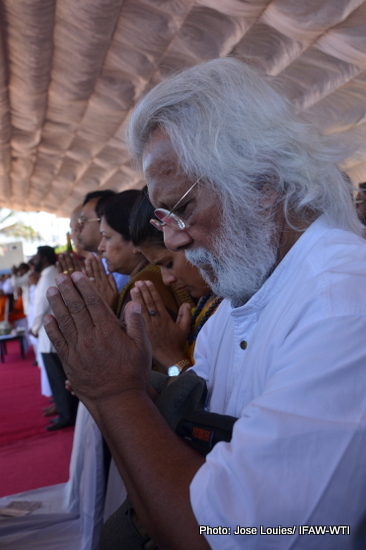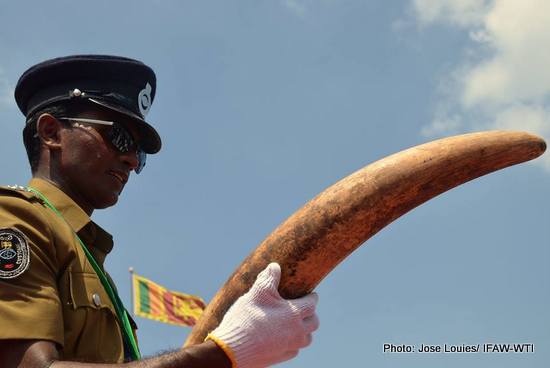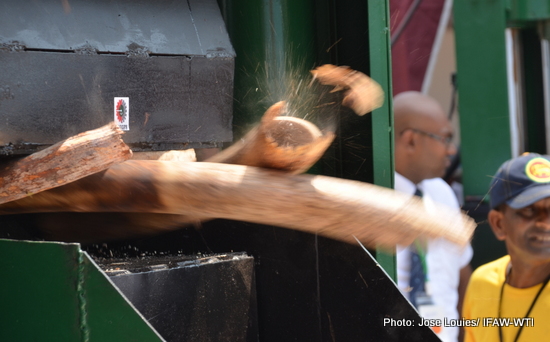Zero Tolerance for Blood Ivory: the Sri Lankan Way
A blog by Jose Louies
Colombo, January 26, 2015: “Mankind was cruel to you! You suffered because some of us were greedy. The last moments of your life were bloody and painful! We who have gathered here represent mankind and with folded hands and humbled hearts ask for your forgiveness. We send our good karmas along with your departed souls to the next life. To another realm, where you will find eternal happiness,” said a monk with his hands folded. His words were followed by Buddhist chants that seemed to float in the sea breeze that swept past us.
A Hindu priest then chanted a mantra from the Upanishads blessing the dead. This was followed by a sermon that ended with the blessings to the departed souls in the name of Jesus Christ by the Catholic Bishop. Finally, an Islamic cleric spoke against all forms of violence and blood bath across the world. He condemned those who killed these innocent creatures for money.
Wondering who they were praying for? They were praying for elephants that were mercilessly butchered to feed the inhuman desire for ivory products. We were witnessing a congregation that went beyond religious lines. Representatives of the world’s four leading religions stood together to condemn and denounce the demand for ivory products for which hundreds of elephants are killed across the globe. January 26 will indeed be remembered as a momentous occasion in the conservation history of Sri Lanka!
We had all gathered here to witness the mass destruction of 359 elephant tusks that was about to begin. These tusks would first be crushed and then turned to ashes. Few thousand people from various countries stood together asking forgiveness from the spirits of these elephants that were killed to feed this demand for “Blood Ivory”.
“The cost of the seized ivory is very huge and for a small country like ours, it could be tempting to keep it for various reasons. But, these are illegal goods with blood on it. It is for this very reason that we don’t want to keep it in our temples or even sell it. As a nation, we would like to set examples for the rest of the world,” said Mr Ravi Karuna Nayaka, Hon’ble Finance Minister. He further stressed that Sri Lanka is ethically and politically determined to act on these issues.
Earlier in the morning I had met Mr Sumith Pilapitiya, a respected Sri Lankan conservationist, over breakfast. Pilapitiya is also a member of the flora and fauna advisory committee of the Ministry of Sustainable Development and Wildlife of Sri Lanka. “Yes, it was a difficult decision for the political leaders and bureaucrats to take- that of destroying ivory worth a fortune,” he said. “There were strong demands for keeping this pile of ivory in temples, which is an age old Sri Lankan tradition. But these should exclusively come from elephants that have died of natural causes. Some such tusks have been in temples for almost a century. But it would be inauspicious to keep this blood ivory in our temples. It is negative karma. And we certainly don’t want that.”
Sri Lanka has managed to set an example in South Asia by destroying illegal ivory. Such moves bring hope that could persuade other countries to do the same and publically destroy “blood ivory”. It should be decimated into dust and turned into ashes. The message should be straight and clear; blood ivory will not be tolerated. This could possibly dissuade poachers and bring down this illicit demand. Such moves could also act as catalyst in mitigating the “blood ivory” trade.
“I am not sure about the use of ivory. All I know is that people kill elephants in the wild to collect ivory which in itself is cruel enough. Ivory is of no need to humans. It is not meant to end up being a decorative item in one’s house,” said a student from the Royal College, Colombo.
The mood around me was overwhelming. I could sense that the Sri Lankan government was committed in their efforts to ensure that there was no place for blood ivory in houses, temples or even in the daily lives of people. And I was proven right when I observed Hon’ble Mr Ravi Karuna Nayaka and John E Scanlon, the Secretary-General of CITES, interact with school children who were invited to attend this event. Ivory destruction should not be a secret and such steps would certainly help spread the message on what it takes to procure ivory.
John E. Scanlon was very strong in his words and congratulated the government for such bold step to destroy ivory. “Ivory has been destroyed across the world but this is the first time it has a religious angle to it. Rituals are being performed before the destruction, which in itself is a strong message for the rest of the world.”
He also appreciated the efforts taken by the government in confiscating ivory and the follow up by the country’s customs department. With the help of Interpol, they were able to trace the origin of ivory to Northern Mozambique and Tanzania. He appreciated the efforts of those involved in tracing the origin of this cache of ivory.
“Sri Lanka is a transit point and shipping is a major source of income for its people. Ivory finds a place in this among other illegally traded goods. It is crucial for our enforcement agencies to always be on the lookout for such contrabands,” added Sumith.
During the sequence of events, I also had an opportunity to meet Mr Gamani Jayawickrama Perera, the Hon. Minister of Sustainable Development and Wildlife just before the ivory was smashed into smithereens. A man with an aura of simplicity, he could easily be mistaken for a common man in the crowd. “It is a bold decision by our government and has the support of both the President and Prime Minister. We are thankful to the religious leadership for their support and blessings; without them this would not have been possible. I am glad that we could set an example and hope that the world will be a much better place if animals are not killed for their body parts.”
As the day passed by, the sun was getting hotter and the sea breeze wasn’t helping. The final ceremony before destroying ivory started with a traditional ritual observed during cremation of a family member. However, this was different. The elephants were adopted as family members by all those assembled who prayed for the peace for the soul of these gentle giants.
Finally, pieces of ivory were placed in the huge hydraulic shredder that crushed each tusk. The leftover was packed in gunny bags under the watchful eyes of armed commandos. The process was slow and I decided to call it a day. Once they are all crushed, these pieces would be taken to a cement factory where they will be turned into ash and immersed in the sea — a symbolic ritual of assuring eternal freedom to the departed souls.
While I waited for my taxi to arrive, an elderly tourist couple, attracted by the gathering, approached me and enquired about what was transpiring. I said, “They are destroying a huge stockpile of blood ivory confiscated from smugglers a few years back.”
They replied in horror, “Blood Ivory? That’s crazy! We know about Blood diamonds, but what is Blood Ivory?” For the next 15 minutes, I informed them how elephants are being killed across countries and that a fierce battle is raging between poachers and forest officers in elephant range countries. I delved on the close association of illegal wildlife traders with arms trafficking, terror activities, corruption, among others were some of the subjects I touched upon.
“That’s crazy! Let me go and have a look. I don’t think I will ever witness ivory being destroyed during my lifetime,” said one of them. They thanked me rushed towards the spot. This was the best thing I have done on this historic day. I could pass on the message of what it takes to get ivory to someone. However, there is still a long way to go before poaching and illegal trade of blood ivory becomes history.

